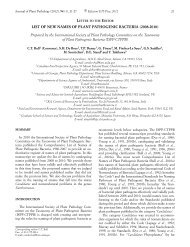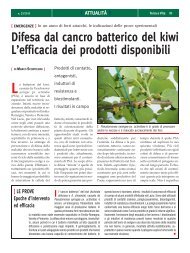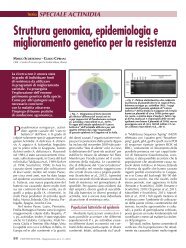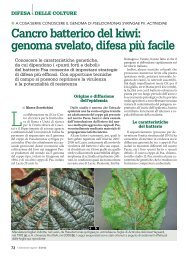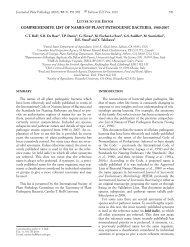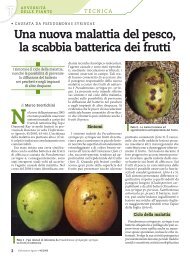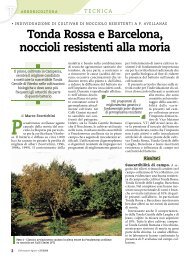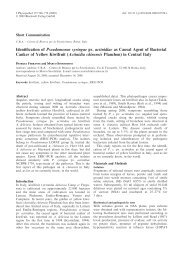Genetic Diversity of Xanthomonas arboricola pv. fragariae Strains ...
Genetic Diversity of Xanthomonas arboricola pv. fragariae Strains ...
Genetic Diversity of Xanthomonas arboricola pv. fragariae Strains ...
Create successful ePaper yourself
Turn your PDF publications into a flip-book with our unique Google optimized e-Paper software.
J. Phytopathology 151, 113–119 (2003)<br />
Ó 2003 Blackwell Verlag, Berlin<br />
ISSN 0931-1785<br />
Istituto Sperimentale per la Frutticoltura, Ciampino Aeroporto, Roma, Italy<br />
<strong>Genetic</strong> <strong>Diversity</strong> <strong>of</strong> <strong>Xanthomonas</strong> <strong>arboricola</strong> <strong>pv</strong>. <strong>fragariae</strong> <strong>Strains</strong><br />
and Comparison with some other X. <strong>arboricola</strong> Pathovars using Repetitive<br />
PCR Genomic Fingerprinting<br />
M. Scortichini* *andM. P. Rossi<br />
Authors’ addresses: Istituto Sperimentale per la Frutticoltura, Via di Fioranello, 52 I-00040 Ciampino Aeroporto, Roma,<br />
Italy. * The author is staff member <strong>of</strong> Istituto Sperimentale per la Patologia Vegetale <strong>of</strong> Rome temporarilyassigned to ISF.<br />
(correspondence to M. Scortichini. E-mail: mscortichini@hotmail.com)<br />
With 6 figures<br />
Received May21, 2002; accepted October 20, 2002<br />
Keywords: <strong>Xanthomonas</strong> <strong>arboricola</strong> <strong>pv</strong>s. corylina, juglandis, pruni, repetitive PCR, strawberryleaf blight<br />
Abstract<br />
The genetic relationship within 26 <strong>Xanthomonas</strong> <strong>arboricola</strong><br />
<strong>pv</strong>. <strong>fragariae</strong> strains and between this pathovar and<br />
20 strains <strong>of</strong> X. <strong>arboricola</strong> <strong>pv</strong>. corylina, 22 strains <strong>of</strong><br />
X. <strong>arboricola</strong> <strong>pv</strong>. juglandis and 16 strains <strong>of</strong> X. <strong>arboricola</strong><br />
<strong>pv</strong>. pruni has been assessed bymeans <strong>of</strong> repetitive polymerase<br />
chain reaction (rep-PCR) using Enterobacterial<br />
Repetitive Intergenic Consensus), BOX (BOXA<br />
subunit <strong>of</strong> the BOX element <strong>of</strong> Streptococcus pneumoniae)<br />
and repetitive extragenic palindromic primer sets.<br />
Cluster analysis was performed by means <strong>of</strong> unweighted<br />
paired group method using arithmetic average (UP-<br />
GMA). Upon rep-PCR and UPGMA cluster analysis, a<br />
relevant genetic diversitywas found within the strains.<br />
The overall similarity, however, was high (i.e. 80%).<br />
The four X. <strong>arboricola</strong> pathovars showed similar but<br />
clearlydifferent genomic patterns and clustered into<br />
four different groups, with X. <strong>arboricola</strong> <strong>pv</strong>. corylina<br />
and X. <strong>arboricola</strong> <strong>pv</strong>. juglandis more closelyrelated to<br />
X. <strong>arboricola</strong> <strong>pv</strong>. <strong>fragariae</strong>. Representative strains <strong>of</strong><br />
X. <strong>arboricola</strong> <strong>pv</strong>. <strong>fragariae</strong> and the putative xanthomonads<br />
isolated from strawberryleaves showing leaf blight<br />
symptoms underwent pathogenicity tests. After artificial<br />
inoculation, X. <strong>arboricola</strong> <strong>pv</strong>. <strong>fragariae</strong> induced necrotic<br />
spots accompanied, sometimes, bya chlorotic halo. The<br />
blackening <strong>of</strong> the leaf veins and peduncle was, sometimes,<br />
also observed. The four putative xanthomonads<br />
isolated from diseased strawberryleaves and not inducing<br />
symptoms after artificial inoculation, clustered<br />
apart from X. <strong>arboricola</strong> pathovars.<br />
Introduction<br />
<strong>Xanthomonas</strong> <strong>arboricola</strong> is a bacterial species (Vauterin<br />
et al., 1995) with restricted pathogenicityand geneticallydifferent<br />
from other <strong>Xanthomonas</strong> species. It<br />
includes pathovars celebensis, corylina, juglandis, poinsetticola<br />
type C strains, populi and pruni (Vauterin et al.,<br />
1995). Recently, Janse et al. (2001) described a new<br />
X. <strong>arboricola</strong> pathovar pathogenic to strawberry[Fragaria<br />
vesca L. x ananassa (Duch.) Guedes.], namely<br />
X. <strong>arboricola</strong> <strong>pv</strong>. <strong>fragariae</strong>, the causative agent <strong>of</strong> bacterial<br />
leaf blight <strong>of</strong> strawberry. Until now, the pathogen<br />
appears more frequentlyin the open-air cultivations<br />
than in the protected cultures. Within this new pathovar,<br />
DNA : DNA hybridization studies pointed out<br />
homologyvalues among the studied strains ranging<br />
from 83 to 100%. The same three strains showed<br />
homologyvalues with X. <strong>arboricola</strong> <strong>pv</strong>. juglandis<br />
NCPPB 411, the pathotype strain, ranging from 71 to<br />
79% (Janse et al., 2001). In addition, fattyacid methyl<br />
ester and amplified fragment length polymorphism analysis<br />
revealed some variability among the 12 X. <strong>arboricola</strong><br />
<strong>pv</strong>. <strong>fragariae</strong> strains tested that were isolated in<br />
Italyon November 1993 (Janse et al., 2001). In order to<br />
enlarge the collection <strong>of</strong> strains <strong>of</strong> this new pathogen,<br />
isolations were performed in the years 1999 and 2000.<br />
Over this period, other 18 putative X. <strong>arboricola</strong> <strong>pv</strong>.<br />
<strong>fragariae</strong> isolates were obtained from strawberryplants<br />
cultivated in northern Italy. Then, a study aimed to<br />
assess the genetic diversity<strong>of</strong> this new pathovar was<br />
performed byusing repetitive polymerase chain reaction<br />
(rep-PCR) with Enterobacterial Repetitive Intergenic<br />
Consensus (ERIC), BOX (BOXA subunit <strong>of</strong> the BOX<br />
element <strong>of</strong> Streptococcus pneumoniae) and repetitive<br />
extragenic palindromic (REP) primer sets. A comparison<br />
with some other economicallyimportant pathovars<br />
<strong>of</strong> X. <strong>arboricola</strong>, namely corylina, juglandis and pruni,<br />
was also carried out bymeans <strong>of</strong> rep-PCR. The pathogenicity<strong>of</strong><br />
some X. <strong>arboricola</strong> <strong>pv</strong>. <strong>fragariae</strong> strains was<br />
also tested. The results <strong>of</strong> this studyare reported herein.<br />
U. S. Copyright Clearance Centre Code Statement: 0931–1785/2003/1513–0113 $ 15.00/0 www.blackwell.de/synergy
114 Scortichini and Rossi<br />
Materials and Methods<br />
Bacterial cultures and isolation<br />
The strains utilized in this studyare listed in Table 1.<br />
Theywere cultured on glucose-yeast extract-calcium<br />
carbonate medium (GYCA) at 25–27°C. Isolations<br />
were performed from visiblyinfected strawberryleaves<br />
showing necrotic lesions on the leaflet blades. Pieces <strong>of</strong><br />
leaf tissue adjacent to necrotic areas as well as portions<br />
<strong>of</strong> midrib, major veins and petioles showing symptoms<br />
resembling those induced by X. <strong>arboricola</strong> <strong>pv</strong>. <strong>fragariae</strong>,<br />
were crushed in sterile mortars containing sterile<br />
saline (0.85% <strong>of</strong> NaCl in distilled water). Tenfold dilutions<br />
were also performed. Aliquots <strong>of</strong> 0.1 ml <strong>of</strong> the<br />
suspensions were spread on GYCA medium and incubated<br />
for 3–4 days at 25–27°C. The mucoid and yellow<br />
colonies were transferred to nutrient agar (Oxoid,<br />
Basingstoke, UK) for purification.<br />
Biochemical and physiological tests<br />
With isolates suspected to belong to X. <strong>arboricola</strong> <strong>pv</strong>.<br />
<strong>fragariae</strong>, the following tests were performed according<br />
to the techniques reported byLelliott and Stead<br />
(1987): oxidative and fermentative metabolism <strong>of</strong> glucose,<br />
oxidase reaction, presence <strong>of</strong> arginine dihydrolase<br />
and catalase, nitrate reduction, hydrolysis <strong>of</strong> esculin,<br />
urea, starch, gelatin and Tween 80, tobacco hypersensitivity.<br />
Whole-cell protein extracts comparison<br />
To confirm the identity<strong>of</strong> the isolates, sodium dodecyl<br />
sulphate-polyacrylanide gel electrophoresis (SDS-<br />
PAGE) <strong>of</strong> soluble whole-cell protein extracts were performed.<br />
Cultures were grown on GYCA for 48 h at<br />
25–27°C. Protein harvesting and extraction were carried<br />
out byfollowing the method <strong>of</strong> Van den Mooter<br />
et al. (1987). The pr<strong>of</strong>iles <strong>of</strong> the isolates were compared<br />
with those <strong>of</strong> X. <strong>arboricola</strong> <strong>pv</strong>. <strong>fragariae</strong> PD<br />
2695, 2696 and 2780. Each strain was examined in<br />
duplicate.<br />
Repetitive PCR genomic fingerprinting and UPGMA analysis<br />
With all strains listed in Table 1, rep-PCR was performed<br />
byusing ERIC, BOX and REP primer sets<br />
according to the procedures <strong>of</strong> Louws et al. (1994). The<br />
ERIC, BOX, and REP primer sets were synthesized by<br />
Eurogentech (Seraing, Belgium). Amplification was<br />
performed in an MJ Research PTC 100 programmable<br />
thermal controller (Watertown, MS, USA). Each 25 ll<br />
reaction mixture contained 200 lm deoxynucleoside<br />
triphosphate, 2 mm MgCl 2 , primers at 60 pmol, Taq<br />
polymerase 1.0 U and 4 ll <strong>of</strong> mineral oil. After thermal<br />
cycling (Louws et al., 1994), the PCR products<br />
were separated byvertical gel electrophoresis on 6%<br />
acrylamide gels in 1X TBE buffer, at 160 V, 4°C for<br />
30 min, in a Bio Rad Mini Protein apparatus (Hercules,<br />
CA, USA) (Scortichini et al., 2001, 2002). The<br />
PCR amplifications were performed in triplicate. The<br />
gels were stained with ethidium bromide and visualized<br />
under a UV transilluminator (Spectroline, Westburg,<br />
NY, USA) and photographed with a Polaroid film<br />
type 55. Gel analysis was made as described by Smith<br />
et al. (1995). The gels were recorded and bands common<br />
to all three amplifications were recorded. For<br />
each primer sets and for each strain, bands were<br />
scored as present (1) or absent (0) and the readings<br />
were entered in a computer file as a binarymatrix.<br />
Similaritycoefficients for all pairwise combinations<br />
were determined using Dice’s coefficients (Dice, 1945)<br />
and clustered byUPGMA bymeans <strong>of</strong> NTSYS<br />
(Numerical TaxonomySystematic) (Exeter S<strong>of</strong>tware,<br />
New York, NY, USA), pc-version, 1.80.<br />
Pathogenicity tests<br />
With X. <strong>arboricola</strong> <strong>pv</strong>. <strong>fragariae</strong> PD 2695, PD 2780<br />
(pathotype strain), ISF F 23, ISF F 26, ISF F 30 and<br />
ISF F 99 representing the groups obtained upon rep-<br />
PCR and UPGMA analysis, pathogenicity tests were<br />
performed. Briefly, pot-cultivated strawberry cultivar<br />
Chandler plants were cultivated, in autumn, in glasshouse<br />
at 20–25°C dayand 8–15°C night temperatures.<br />
Bacterial suspensions in sterile physiological saline<br />
(0.85% <strong>of</strong> NaCl in distilled water, SPS) were prepared<br />
from 48-h-old colonies grown on GYCA. A concentration<br />
<strong>of</strong> 1–2 · 10 7 cells/ml was used. Single leaflets were<br />
inoculated bypuncturing major veins and peduncles<br />
and byplacing 10 ll <strong>of</strong> the suspension on the wound.<br />
Six leaflets and six peduncles per each strain were<br />
inoculated. Control leaves were inoculated with SPS<br />
only. Symptom development was assessed up to<br />
60 days after the inoculations. Re-isolations were carried<br />
out after the appearance <strong>of</strong> symptoms.<br />
Results<br />
Isolations, biochemical tests and SDS-PAGE <strong>of</strong> protein<br />
extracts<br />
The GYCA medium frequentlyallowed the isolation <strong>of</strong><br />
mucoid and yellow-pigmented bacteria from infected<br />
strawberryleaves. However, only18 isolates showed<br />
the biochemical features showed by X. <strong>arboricola</strong> <strong>pv</strong>.<br />
<strong>fragariae</strong>: oxidative metabolism <strong>of</strong> glucose, oxidase<br />
reaction-negative, presence <strong>of</strong> catalase, absence <strong>of</strong><br />
arginine dihydrolase and nitrate reduction, esculin,<br />
starch and gelatin hydrolysis-positive, urease and<br />
Tween 80 hydrolysis-negative, tobacco hypersensitivitypositive.<br />
This last test resulted in a delay<strong>of</strong> 48 h for<br />
ISF F 26, ISF F 29, ISF F 30 and ISF F 31. The visual<br />
comparison <strong>of</strong> protein extracts, upon SDS-PAGE,<br />
revealed an identical pr<strong>of</strong>ile between X. <strong>arboricola</strong> <strong>pv</strong>.<br />
<strong>fragariae</strong> PD 2695, PD 2696, PD 2780 isolated in 1993<br />
and the isolates obtained in 1999 and 2000, with the<br />
exception <strong>of</strong> ISF F 26, ISF F 29, ISF F 30 and ISF F 31<br />
which showed qualitative diversityin the pr<strong>of</strong>ile pattern.<br />
Pathogenicity test<br />
<strong>Xanthomonas</strong> <strong>arboricola</strong> <strong>pv</strong>. <strong>fragariae</strong> strains PD 2780<br />
and PD 2695 as well as ISF F 23 and ISF F 99<br />
induced discoloration <strong>of</strong> the veins 10–15 days after the<br />
inoculation, whereas the peduncle started to become
<strong>Genetic</strong> <strong>Diversity</strong><strong>of</strong> <strong>Xanthomonas</strong> <strong>Strains</strong><br />
115<br />
Table 1<br />
List <strong>of</strong> strains used in this study Strain Host plant CountryYear <strong>of</strong> isolation<br />
<strong>Xanthomonas</strong> <strong>arboricola</strong> <strong>pv</strong>. <strong>fragariae</strong><br />
PD 2694 Frag. x an. Italy1993<br />
PD 2695 Frag. x an. Italy1993<br />
PD 2696 Frag. x an. Italy1993<br />
PD 2697 Frag. x an. Italy1993<br />
PD 2698 Frag. x an. Italy1993<br />
PD 2699 Frag. x an. Italy1993<br />
PD 2780 T Frag. x an. Italy1993<br />
PD 2782 Frag. x an. Italy1993<br />
PD 2803 Frag. x an. Italy1993<br />
PD 2804 Frag. x an. Italy1993<br />
PD 2805 Frag. x an. Italy1993<br />
PD 2806 Frag. x an. Italy1993<br />
ISF F23 Frag. x an. Italy1999<br />
ISF F99 Frag. x an. Italy1999<br />
ISF F113 Frag. x an. Italy2000<br />
ISF F115 Frag. x an. Italy2000<br />
ISF F116 Frag. x an. Italy2000<br />
ISF F124 Frag. x an. Italy2000<br />
ISF F126 Frag. x an. Italy2000<br />
ISF F128 Frag. x an. Italy2000<br />
ISF F129 Frag. x an. Italy2000<br />
ISF F130 Frag. x an. Italy2000<br />
ISF F135 Frag. x an. Italy2000<br />
ISF F136 Frag. x an. Italy2000<br />
ISF F137 Frag. x an. Italy2000<br />
ISF F139 Frag. x an. Italy2000<br />
<strong>Xanthomonas</strong> <strong>arboricola</strong> <strong>pv</strong>. corylina<br />
NCPPB 2896 C. avellana UK 1976<br />
NCPPB 3037 C. avellana UK 1977<br />
NCPPB 3339 C. avellana France 1984<br />
PD 1896 C. avellana The Netherlands 1991<br />
PD 1897 C. avellana The Netherlands 1991<br />
PD 3657 C. avellana Germany1999<br />
Fil 6 C. avellana USA (Oregon) Unknown<br />
Fil 19 C. avellana USA (Oregon) Unknown<br />
Fil 29 C. avellana USA (Oregon) Unknown<br />
Fil 85 C. avellana USA (Oregon) Unknown<br />
ISF F Nc1 C. avellana Italy1996<br />
ISF F Nc2 C. avellana Italy1996<br />
ISF F Nc4 C. avellana Italy1997<br />
ISF F Nc5 C. avellana Italy1997<br />
ISF F Nc6 C. avellana Italy1998<br />
ISF F Nc7 C. avellana Italy1998<br />
ISF F Nc 9 C. avellana Italy1999<br />
ISF F Nc10 C. avellana Italy1999<br />
ISF F Nc 14 C. avellana Italy2000<br />
ISF F Nc 15 C. avellana Italy2000<br />
<strong>Xanthomonas</strong> <strong>arboricola</strong> <strong>pv</strong>. juglandis<br />
NCCPB 411 T J. regia New Zealand 1957<br />
NCPPB 412 J. regia New Zealand 1957<br />
NCPPB 413 J. regia New Zealand 1957<br />
NCPPB 362 J. regia UK 1955<br />
NCPPB 1659 J. regia UK 1964<br />
NCPPB 1447 J. regia Romania 1963<br />
NCPPB 2927 J. regia Iran 1977<br />
NCPPB 3340 J. regia France 1984<br />
PD 130 J. regia The Netherlands 1978<br />
PD 157 J. regia The Netherlands 1987<br />
PD 2365 J. regia The Netherlands 1994<br />
PD 2277 J. regia The Netherlands 1993<br />
BPIC 279 J. regia Greece 1970<br />
BPIC 281 J. regia Greece 1970<br />
BPIC 349 J. regia Greece 1971<br />
BPIC 733 J. regia Greece 1979<br />
IVIA 1317.3 J. regia Spain 1993<br />
IVIA 1325. 2b J. regia Spain 1993<br />
ISF FN1 J. regia Italy1991<br />
ISF FN2 J. regia Italy1995<br />
ISF FN3 J. regia Italy1999<br />
ISF FN12 J. regia Italy1999
116 Scortichini and Rossi<br />
Strain Host plant CountryYear <strong>of</strong> isolation<br />
<strong>Xanthomonas</strong> <strong>arboricola</strong> <strong>pv</strong>. pruni<br />
NCPPB 416 T P. salicina New Zealand 1957<br />
NCPPB 417 P. salicina New Zealand 1957<br />
NCPPB 926 P. domestica South Africa 1961<br />
NCPPB 1607 P. persica Australia 1964<br />
NCPPB 2587 P. armeniaca South Africa 1964<br />
NCPPB 2588 P. persica South Africa 1964<br />
NCPPB 3156 P. persica Italy1981<br />
NCPPB 3877 P. salicina Italy1990<br />
NCPPB 3878 P. salicina Italy1991<br />
ISF FXP1 P. salicina Italy1995<br />
ISF FXP2 P. salicina Italy1995<br />
ISF FXP3 P. persica Italy1995<br />
ISF FXP11 P. salicina Italy2000<br />
ISF FXP12 P. salicina Italy2000<br />
ISF FXP13 P. salicina Italy2000<br />
ISF FXP14 P. salicina Italy2000<br />
Unknown xanthomonads<br />
ISF F26 Frag. x an. Italy1999<br />
ISF F29 Frag. x an. Italy1999<br />
ISF F30 Frag. x an. Italy1999<br />
ISF F31 Frag. x an. Italy1999<br />
Table 1<br />
(Continued)<br />
T : Pathotype strain; Frag. x an. :Fragaria vesca x ananassa; C. avellana: Corylus avellana; J. regia: Juglans<br />
regia; P. armeniaca: Prunus armeniaca; P. domestica: Prunus domestica; P. salicina: Prunus salicina;<br />
P. persica: Prunus persica.<br />
NCCPB: National Collection <strong>of</strong> Plant Pathogenic Bacteria, York, United Kingdom; PD: Plant Protection<br />
Service, Wageningen, The Netherlands; BPIC: Culture Collection <strong>of</strong> Benaki Phytopathological<br />
Institute, Kiphissia-Athens, Greece; IVIA: Instituto Valenciano de Investigaciones Agrarias, Moncada-<br />
Valencia, Spain; ISF: Culture Collection <strong>of</strong> Istituto Sperimentale per la Frutticoltura, Roma, Italy.<br />
reddish 15–18 days after the inoculation. Blackening<br />
<strong>of</strong> the veins and a subsequent necrosis <strong>of</strong> the leaf tissue<br />
was observed 1 month after the inoculation. Afterwards,<br />
a chlorotic halo was, sometimes, noticed<br />
around the necrotic tissue. The leaf blight symptom<br />
was observed onlyin some symptomatic leaves showing<br />
necrosis and chlorotic halo, approximately<br />
2 months after the inoculation. <strong>Xanthomonas</strong> <strong>arboricola</strong><br />
<strong>pv</strong>. <strong>fragariae</strong> strain PD 2780 (pathotype strain) was<br />
the most aggressive, causing blight in four leaflets,<br />
whereas ISF F 23 inciting blight onlyon one leaflet<br />
was the least aggressive. The blackening <strong>of</strong> the peduncle<br />
was observed onlyin some cases and mainly<br />
with strain PD 2780 that induced such a symptom on<br />
three <strong>of</strong> the six inoculated peduncles. Isolates ISF F 26<br />
and ISF F 30 induced onlya slight discoloration<br />
around the inoculation site that never developed into a<br />
necrotic tissue. Re-isolations on GYCA performed<br />
from symptomatic leaflets and peduncles yielded yellow-pigmented<br />
colonies identical to X. <strong>arboricola</strong> <strong>pv</strong>.<br />
<strong>fragariae</strong> upon SDS-PAGE.<br />
On the basis <strong>of</strong> biochemical tests, SDS-PAGE comparison<br />
<strong>of</strong> protein extract pr<strong>of</strong>iles with type and reference<br />
strains <strong>of</strong> X. <strong>arboricola</strong> <strong>pv</strong>. <strong>fragariae</strong> and<br />
pathogenicitytests, we conclude that the 14 isolates listed<br />
in Table 1 belong to X. <strong>arboricola</strong> <strong>pv</strong>. <strong>fragariae</strong>. ISF<br />
F 26, ISF F 29, ISF F 30 and ISF F 31 could not be classified,<br />
although, probably, they are xanthomonads.<br />
Repetitive PCR genomic fingerprinting<br />
ERIC, BOX and REP primer sets gave reproducible<br />
genomic PCR pr<strong>of</strong>iles consisting <strong>of</strong> bands <strong>of</strong> approximately100–1700<br />
bp. The bands were clearlydifferentiated<br />
byPAGE. For UPGMA analysis, a total <strong>of</strong> 41<br />
reproducible, clearlyresolved bands were scored: 18<br />
for primers ERIC, 14 for primer BOX and nine for<br />
primer REP. ERIC and BOX primers were more discriminative<br />
than REP in differentiating the X. <strong>arboricola</strong><br />
<strong>pv</strong>. <strong>fragariae</strong> strains. Representative genomic<br />
patterns are shown in Fig. 1–4. *UPGMA analysis<br />
Fig. 1 Polymerase chain reaction fingerprinting patterns from<br />
genomic DNA <strong>of</strong> <strong>Xanthomonas</strong> <strong>arboricola</strong> <strong>pv</strong>. <strong>fragariae</strong> and putative<br />
xanthomonads strains, obtained byusing enterobacterial repetitive<br />
intergenic consensus primer sets. m: molecular size marker (1-kb ladder,<br />
Gibco BRL, Life Technologies, Italy); the sizes are indicated in<br />
base pairs. Lane 1: ISF F 29; lane 2: ISF F 30; lane 3: X. <strong>arboricola</strong><br />
<strong>pv</strong>. <strong>fragariae</strong> PD 2697; lane 4: X. <strong>arboricola</strong> <strong>pv</strong>. <strong>fragariae</strong> PD 2696;<br />
lane 5: X. <strong>arboricola</strong> <strong>pv</strong>. <strong>fragariae</strong> PD 2782; lane 6: X. <strong>arboricola</strong> <strong>pv</strong>.<br />
<strong>fragariae</strong> 2695
<strong>Genetic</strong> <strong>Diversity</strong><strong>of</strong> <strong>Xanthomonas</strong> <strong>Strains</strong><br />
117<br />
Fig. 2 Polymerase chain reaction fingerprinting patterns from<br />
genomic DNA <strong>of</strong> <strong>Xanthomonas</strong> <strong>arboricola</strong> <strong>pv</strong>. <strong>fragariae</strong> and putative<br />
xanthomonads strains, obtained byusing enterobacterial repetitive<br />
intergenic consensus primer sets. m: molecular size marker (1-kb ladder,<br />
Gibco BRL, Life Technologies, Italy); the sizes are indicated in<br />
base pairs. Lane 1: X. <strong>arboricola</strong> <strong>pv</strong>. <strong>fragariae</strong> ISF F 128; lane 2:<br />
X. <strong>arboricola</strong> <strong>pv</strong>. <strong>fragariae</strong> ISF F 124; lane 3: X. <strong>arboricola</strong> <strong>pv</strong>.<strong>fragariae</strong><br />
ISF F 116; lane 4: X. <strong>arboricola</strong> <strong>pv</strong>. <strong>fragariae</strong> ISF F 115; lane 5:<br />
ISF F 26; lane 6: ISF F 23<br />
Fig. 4 Polymerase chain reaction fingerprinting patterns from<br />
genomic DNA <strong>of</strong> <strong>Xanthomonas</strong> <strong>arboricola</strong> <strong>pv</strong>. corylina, X. <strong>arboricola</strong><br />
<strong>pv</strong>. juglandis, X. <strong>arboricola</strong> <strong>pv</strong>. pruni and putative xanthomonad<br />
strains, obtained byusing BOX primer set. m: molecular size marker<br />
(1-kb ladder, Gibco BRL, Life Technologies, Italy); the sizes are<br />
indicated in base pairs. Lane 1: X. <strong>arboricola</strong> <strong>pv</strong>. juglandis NCPPB<br />
483; lane 2: X. <strong>arboricola</strong> <strong>pv</strong>. juglandis 411 T ; lane 3: X. <strong>arboricola</strong> <strong>pv</strong>.<br />
pruni NCPPB 416 T ; lane 4: X. <strong>arboricola</strong> <strong>pv</strong>. pruni NCPPB 417; lane<br />
5: X. <strong>arboricola</strong> <strong>pv</strong>. corylina Fil 6; lane 6: ISF F 31. Note the different<br />
genomic pattern <strong>of</strong> ISF F 31<br />
Similarity (%)<br />
25 50 75 100<br />
Fig. 3 Polymerase chain reaction fingerprinting patterns from<br />
genomic DNA <strong>of</strong> <strong>Xanthomonas</strong> <strong>arboricola</strong> <strong>pv</strong>. <strong>fragariae</strong>. X. <strong>arboricola</strong><br />
<strong>pv</strong>. corylina, X. <strong>arboricola</strong> <strong>pv</strong>. juglandis and X. <strong>arboricola</strong> <strong>pv</strong>. pruni<br />
strains, obtained byusing BOX primer set. m: molecular size marker<br />
(1-kb ladder, Gibco BRL, Life Technologies, Italy); the sizes are<br />
indicated in base pairs. Lane 1: X. <strong>arboricola</strong> <strong>pv</strong>. juglandis NCPPB<br />
483; lane 2: X. <strong>arboricola</strong> <strong>pv</strong>. juglandis 411 T ; lane 3: X. <strong>arboricola</strong> <strong>pv</strong>.<br />
pruni NCPPB 416 T ; lane 4: X. <strong>arboricola</strong> <strong>pv</strong>. pruni NCPPB 417; lane<br />
5: X. <strong>arboricola</strong> <strong>pv</strong>. corylina Fil 6; lane 6: X. <strong>arboricola</strong> <strong>pv</strong>. <strong>fragariae</strong><br />
PD 2780 T<br />
revealed a relevant diversityamong the 26 X. <strong>arboricola</strong><br />
<strong>pv</strong>. <strong>fragariae</strong> strains because each strain showed a<br />
unique pr<strong>of</strong>ile. The overall similarity, however, is high<br />
(i.e. >80%) (Fig. 5). Each <strong>of</strong> the representative strains<br />
<strong>of</strong> X. <strong>arboricola</strong> <strong>pv</strong>. juglandis, X. <strong>arboricola</strong> <strong>pv</strong>. corylina<br />
and X. <strong>arboricola</strong> <strong>pv</strong>. pruni showed a similar but<br />
clearlydifferent pr<strong>of</strong>ile from X. <strong>arboricola</strong> <strong>pv</strong>. <strong>fragariae</strong><br />
(Figs 3 and 4) and clustered apart (Fig. 5). When<br />
UPGMA analysis was carried out with all the strains<br />
listed in Table 1, the four pathovars studied formed<br />
four different clusters with X. <strong>arboricola</strong> <strong>pv</strong>. juglandis<br />
and X. <strong>arboricola</strong> <strong>pv</strong>. corylina the most closelyrelated<br />
(Fig. 6). Also ISF F 26, ISF F 29, ISF F 30 and ISF<br />
PD 2695<br />
PD 2694<br />
PD 2699<br />
PD 2782<br />
PD 2803<br />
PD 2698<br />
PD 2804<br />
PD 2805<br />
PD 2806<br />
PD 2780 T<br />
PD 2697<br />
PD 2696<br />
ISF F 99<br />
ISF F 113<br />
ISF F 139<br />
ISF F 126<br />
ISF F 130<br />
ISF F 116<br />
ISF F 135<br />
ISF F 136<br />
ISF F 129<br />
ISF F 115<br />
ISF 23<br />
ISF F 124<br />
ISF F 128<br />
ISF F 137<br />
X. <strong>arboricola</strong><br />
<strong>pv</strong>. juglandis NCPPB 411 T<br />
X. <strong>arboricola</strong><br />
<strong>pv</strong>. corylina NCPPB 2896<br />
X. <strong>arboricola</strong><br />
<strong>pv</strong>. pruni NCPPB 416T<br />
ISF F 26<br />
ISF F 29 unknown<br />
ISF F 30 xanthomonads<br />
ISF F 31<br />
Fig. 5 Dendrogram showing relationship between <strong>Xanthomonas</strong><br />
<strong>arboricola</strong> <strong>pv</strong>. <strong>fragariae</strong> strains, representative and type-strains <strong>of</strong><br />
X. <strong>arboricola</strong> <strong>pv</strong>s. corylina, juglandis and pruni, and putative xanthomonads<br />
isolated from diseased strawberryleaves<br />
F 31, the strains that induced a delayed hypersensitivityreaction<br />
<strong>of</strong> the tobacco leaves, showed a distinctive<br />
pattern and clustered apart from all the other<br />
X. <strong>arboricola</strong> strains (Fig. 5). In addition, all <strong>of</strong> the<br />
four strains showed the same genomic pr<strong>of</strong>ile.<br />
Discussion<br />
This studyshowed that genetic variabilityis present in<br />
X. <strong>arboricola</strong> <strong>pv</strong>. <strong>fragariae</strong> strains isolated in Italy.
118 Scortichini and Rossi<br />
Similarity (%)<br />
25 50 75 100<br />
X. <strong>arboricola</strong><br />
<strong>pv</strong>. juglandis<br />
X. <strong>arboricola</strong><br />
<strong>pv</strong>. corylina<br />
X. <strong>arboricola</strong><br />
<strong>pv</strong>. <strong>fragariae</strong><br />
X. <strong>arboricola</strong><br />
<strong>pv</strong>. pruni<br />
Fig. 6 Simplified dendrogram showing relationships between <strong>Xanthomonas</strong><br />
<strong>arboricola</strong> <strong>pv</strong>s. corylina, <strong>fragariae</strong>, juglandis and pruni. Cluster<br />
analysis obtained by means <strong>of</strong> unweighted paired group method<br />
using arithmetic average with Dice’s coefficients after repetitive<br />
polymerase chain reaction using enterobacterial repetitive intergenic<br />
consensus, BOX and repetitive extragenic palindromic primer sets<br />
Rep-PCR and UPGMA analysis indicated that each<br />
strain has a distinct genomic pr<strong>of</strong>ile, although the<br />
overall similarity<strong>of</strong> the patterns is high (i.e. around<br />
80%). Further studies, taking into account the population<br />
structure <strong>of</strong> the pathogen (Maynard Smith et al.,<br />
1993), are necessaryto assess if such a relevant genetic<br />
diversityis related to a real panmictic structure <strong>of</strong> the<br />
pathovar. In addition, the present study, performed<br />
with more strains than previously(Janse et al., 2001),<br />
confirms that such a new pathovar represents a distinct<br />
group within X. <strong>arboricola</strong>, with X. <strong>arboricola</strong> <strong>pv</strong>. corylina<br />
and X. <strong>arboricola</strong> <strong>pv</strong>. juglandis as the closest pathovars.<br />
Rep-PCR, based on primers targeting the highly<br />
conserved DNA sequences present in bacterial species,<br />
once more confirms its capabilityto easilydiscriminate<br />
among closelyrelated phytopathogenic bacteria<br />
(Louws et al., 1999) and its used as a rapid and discriminatorytechnique<br />
to determine taxonomic diversity(Rademaker<br />
et al., 2000). The presence <strong>of</strong> these<br />
xanthomonads would be worthy<strong>of</strong> consideration<br />
also outside Italyas strawberrycultivation, nowadays,<br />
is based on an extensive exchange <strong>of</strong> propagative<br />
material on a world-wide scale. <strong>Genetic</strong> assessment by<br />
means <strong>of</strong> rep-PCR also ascertained that we isolated<br />
other xanthomonads <strong>of</strong> uncertain identitythat exhibit<br />
substantial pathogenic and genetic diversityfrom<br />
X. <strong>arboricola</strong> <strong>pv</strong>. <strong>fragariae</strong>. Interestingly, this group<br />
did not induce any significant symptom to strawberry.<br />
These findings indicate that pathogenic and putative<br />
non-pathogenic xanthomonads can be present at the<br />
same time in/on strawberryleaves. Non-pathogenic<br />
xanthomonads have been repeatedlyisolated from<br />
various plant material such as apple explants (Maas<br />
et al., 1985), vegetables and fruits (Liao and Wells,<br />
1987), mixed infections in tomato and pepper transplants<br />
(Gitaitis et al., 1987), bean debris (Gilbertson et<br />
al., 1990) weeds (Angeles-Ramos et al., 1991). In an<br />
extensive studycarried out with non-pathogenic xanthomonads,<br />
Vauterin et al. (1996) showed that none <strong>of</strong><br />
the 70 strains tested induced symptoms on the plants<br />
from which theywere originallyisolated. Moreover,<br />
the identification <strong>of</strong> such strains was rather ambiguous<br />
and theycould not be classified in the known pathovar<br />
system (Vauterin et al., 1996). The ecological role <strong>of</strong><br />
such non-pathogenic xanthomonads is unknown, and<br />
Vauterin et al. (1996) argued that theycould represent<br />
pathogenic <strong>Xanthomonas</strong> strains with still unknown<br />
host plant(s), being able to live as resident or epiphytes<br />
on manyplants or that theycan become pathogenic<br />
onlyunder certain specific conditions. Our experience<br />
with X. <strong>arboricola</strong> <strong>pv</strong>. <strong>fragariae</strong> strains indicate that<br />
this micro-organism incites the leaf blight symptom<br />
mainlyin open-field cultivation and during midautumn<br />
weather conditions characterized bya very<br />
high humiditycontent <strong>of</strong> the air. In fact, it is not<br />
always possible to artificially reproduce in glasshouse<br />
the symptoms observed in the field and the leaf blight<br />
symptoms are visible many weeks after the inoculation.<br />
Ecological and/or edaphic factors, possibly<br />
favouring the phytopathogenic activity <strong>of</strong> X. <strong>arboricola</strong><br />
<strong>pv</strong>. <strong>fragariae</strong> are still unknown.<br />
In conclusion, the isolation <strong>of</strong> yellow-pigmented<br />
bacteria from strawberryleaves is not rare, whereas<br />
the recovery<strong>of</strong> putative X. <strong>arboricola</strong> <strong>pv</strong>. <strong>fragariae</strong><br />
would seem less frequent (R. Gozzi and A. Calzolari,<br />
personal communication). In addition, X. <strong>arboricola</strong><br />
<strong>pv</strong>. <strong>fragariae</strong> and X. <strong>fragariae</strong> can be, sometimes, contemporaneouslyisolated<br />
either from strawberryplants<br />
with symptoms <strong>of</strong> angular leaf spot or with leaf blight<br />
(Scortichini, 1996). These findings indicate that mixed<br />
infections due to the contemporaneous presence <strong>of</strong> the<br />
two pathogens can occur on strawberryplants. Moreover,<br />
it has been ascertained that, within X. <strong>fragariae</strong>,<br />
different populations <strong>of</strong> the pathogen do exist either in<br />
the United States and Canada or Europe (Opgenorth<br />
et al., 1996; Pooler et al., 1996; Roberts et al., 1998;<br />
Janse et al., 2001). Consequently, an update <strong>of</strong> the<br />
techniques aiming to detect the pathogenic xanthomonads<br />
in the strawberrypropagative material would<br />
seem important.<br />
Acknowledgements<br />
The authors wish to thank the following colleagues for having supplied<br />
<strong>Xanthomonas</strong> <strong>arboricola</strong> strains: J.D. Janse (Plant Protection Service,<br />
Wageningen, The Netherlands); M.M. Lopez (Instituto Valenciano de<br />
Investigaciones Agrarias, Moncada-Valencia, Spain); P.G. Psallidas<br />
(Benaki Phytopathological Institute, Kiphissia-Athens, Greece); D.E.<br />
Stead (Central Science Laboratory, York, United Kingdom).<br />
References<br />
Angeles-Ramos, R., A. K. Vidaver, P. Flynn (1991): Characterization<br />
<strong>of</strong> epiphytic <strong>Xanthomonas</strong> campestris <strong>pv</strong>. phaseoli and pectolytic<br />
xanthomonads recovered from symptomless weeds in the<br />
Dominican Republic. Phytopathology 81, 677–681.<br />
Dice, L. R. (1945): Measurement <strong>of</strong> the amount <strong>of</strong> ecological association<br />
between species. Ecology 26, 297–302.<br />
Gilbertson, R. L., R. E. Rand, D. J. Hagedorn (1990): Survival <strong>of</strong><br />
<strong>Xanthomonas</strong> campestris <strong>pv</strong>. phaseoli and pectolytic strains <strong>of</strong> <strong>Xanthomonas</strong><br />
campestris in bean debris. Plant Dis. 74, 322–327.<br />
Gitaitis, R. D., M. J. Sasser, R. W. Beaver, T. B. Mc Innes, R. E.<br />
Stall (1987): Pectolytic xanthomonads in mixed infections with
<strong>Genetic</strong> <strong>Diversity</strong><strong>of</strong> <strong>Xanthomonas</strong> <strong>Strains</strong><br />
Pseudomonas syringae <strong>pv</strong>. syringae, P. s. <strong>pv</strong>. tomato, and <strong>Xanthomonas</strong><br />
campestris <strong>pv</strong>. vesicatoria in tomato and pepper transplants.<br />
Phytopathology 77, 611–615.<br />
Janse, J. D., M. P. Rossi, R. F. J. Gorkink, J. H. J. Derks,<br />
J. Swings, D. Jannsens, M. Scortichini (2001): Bacterial leaf blight<br />
<strong>of</strong> strawberry(Fragaria x ananassa) caused bya pathovar <strong>of</strong> <strong>Xanthomonas</strong><br />
<strong>arboricola</strong>, not similar to <strong>Xanthomonas</strong> <strong>fragariae</strong> Kennedy&<br />
King. Description <strong>of</strong> the causal organism as <strong>Xanthomonas</strong><br />
<strong>arboricola</strong> <strong>pv</strong>. <strong>fragariae</strong> (<strong>pv</strong>. nov., comb. nov.). Pl. Pathol. 50,<br />
653–665.<br />
Lelliott, R. A., D. E. Stead (1987): Methods for the diagnosis <strong>of</strong> bacterial<br />
diseases <strong>of</strong> plants. Blackwell Scientific Publications for the<br />
British Society<strong>of</strong> Plant Pathology, Oxford, UK.<br />
Liao, G. H., J. M. Wells (1987): Association <strong>of</strong> pectolytic strains <strong>of</strong><br />
<strong>Xanthomonas</strong> campestris with s<strong>of</strong>t rots <strong>of</strong> fruits and vegetables at<br />
retail markets. Phytopathology 77, 418–422.<br />
Louws, F. J., D. W. Fullbright, C. T. Stephens, F. J. De Bruijn<br />
(1994): Specific genomic fingerprints <strong>of</strong> phytopathogenic <strong>Xanthomonas</strong><br />
and Pseudomonas pathovars and strains generated with<br />
repetitive sequences and PCR. Appl. Environ. Microbiol. 60,<br />
2286–2295.<br />
Louws, F. J., J. L. W. Rademaker, F. J. De Bruijn (1999): The three<br />
Ds <strong>of</strong> PCR-based genomic analysis <strong>of</strong> phytobacteria: diversity,<br />
detection, and disease diagnosis. Ann. Rev. Phytopath. 37, 81–125.<br />
Maas, J. J., M. M. Finney, E. L. Civerolo, M. Sasser (1985): Association<br />
<strong>of</strong> an unusual strain <strong>of</strong> <strong>Xanthomonas</strong> campestris with apple.<br />
Phytopathology 75, 438–445.<br />
Maynard Smith, J., N. H. Smith, M. O’Rourke, B. G. Spratt (1993):<br />
How clonal are bacteria Proc. Natl Acad. Sci. U.S.A. 90, 4384–<br />
4388.<br />
Opgenorth, D. C., C. D. Smart, F. J. Louws, F. J. De Bruijn,<br />
B. C. Kirkpatrick (1996): Identification <strong>of</strong> <strong>Xanthomonas</strong> <strong>fragariae</strong><br />
field isolates byrep-PCR genomic fingerprinting. Plant Dis. 80,<br />
868–873.<br />
Pooler, M. R., D. F. Ritchie, J. S. Hartung (1996): <strong>Genetic</strong> relationships<br />
among strains <strong>of</strong> <strong>Xanthomonas</strong> <strong>fragariae</strong> based on random<br />
amplified polymorphic DNA PCR, repetitive extragenic palindromic<br />
PCR, and enterobacterial repetitive intergenic consensus<br />
PCR data and generation <strong>of</strong> multiplex PCR primers useful for the<br />
identification <strong>of</strong> this phytopathogen. Appl. Environ. Microbiol.<br />
62, 3121–3127.<br />
Rademaker, J. L. W., B. Hoste, F. J. Louws, K. Kersters, J. Swings,<br />
L. Vauterin, P. Vauterin, F. J. De Bruijn (2000): Comparison <strong>of</strong><br />
AFLP and rep-PCR genomic fingerprinting with DNA–DNA<br />
homologystudies: <strong>Xanthomonas</strong> as a model system. Int. J. Syst.<br />
Evol. Microbiol. 50, 665–677.<br />
Roberts, P. D., N. C. Hodge, H. Bouzar, J. B. Jones, R. E. Stall,<br />
R. D. Berger, A. R. Chase (1998): Relatedeness <strong>of</strong> strains <strong>of</strong> <strong>Xanthomonas</strong><br />
<strong>fragariae</strong> byrestriction fragment length polymorphism,<br />
DNA–DNA reassociation, and fattyacid analysis. Appl. Environ.<br />
Microbiol. 64, 3961–3965.<br />
Scortichini, M. (1996): Una nuova batteriosi della fragola causata da<br />
<strong>Xanthomonas</strong> campestris. Frutticoltura LVIII (6), 51–53.<br />
Scortichini, M., U. Marchesi, P. Di Prospero (2001): <strong>Genetic</strong> diversity<strong>of</strong><br />
<strong>Xanthomonas</strong> <strong>arboricola</strong> <strong>pv</strong>. juglandis (synonyms: X. campestris<br />
<strong>pv</strong>. juglandis; X. juglandis <strong>pv</strong>. juglandis) strains from<br />
different geographical areas shown byrepetitive polymerase chain<br />
reaction. J. Phytopathol. 149, 325–332.<br />
Scortichini, M., M. P. Rossi, U. Marchesi (2002): <strong>Genetic</strong>, phenotypic<br />
and pathogenic diversity<strong>of</strong> <strong>Xanthomonas</strong> <strong>arboricola</strong> <strong>pv</strong>. corylina<br />
strains question the representative nature <strong>of</strong> the type strain. Pl.<br />
Pathol. 51 (in press).<br />
Smith, J. J., L. C. Offord, M. Holderness, G. S. Saddler (1995): <strong>Genetic</strong><br />
diversity<strong>of</strong> Burkholderia solanacearum (synonym: Pseudomonas<br />
solanacearum) race 3 in Kenya. Appl. Environ. Microbiol. 61,<br />
4263–4268.<br />
Van den Mooter, M. M. Steenackers, C. Maertens, F. Gossele,<br />
P. de Vos, J. Swings, K. Kerters, J. de Ley(1987): Differentiation<br />
between <strong>Xanthomonas</strong> campestris <strong>pv</strong>. graminis (ISPP list 1980), <strong>pv</strong>.<br />
phleipratensis (ISPP list 1980) emend., <strong>pv</strong>. poae Egli and Schmidt<br />
1982 and <strong>pv</strong>. arrenatheri Egli and Schmidt bynumerical analysis<br />
<strong>of</strong> phenotypic features and protein gel electrophoresis. J. Phytopathol.<br />
118, 135–156.<br />
Vauterin, L., B. Hoste, K. Kersters, J. Swings (1995): Reclassification<br />
<strong>of</strong> <strong>Xanthomonas</strong>. Int. J. Syst. Bacteriol. 45, 472–489.<br />
Vauterin, L., P. Yang, A. Alvarez, Y. Takikawa, D. A. Roth,<br />
A. K. Vidaver, R. E. Stall, K. Kersters, J. Swings (1996): Identification<br />
<strong>of</strong> non-pathogenic <strong>Xanthomonas</strong> strains associated with<br />
plants. Syst. Appl. Microbiol. 19, 96–105.<br />
119



